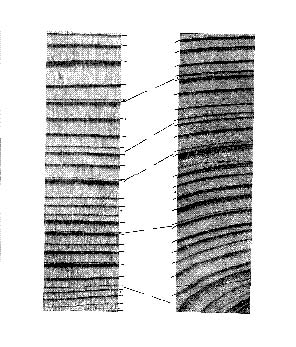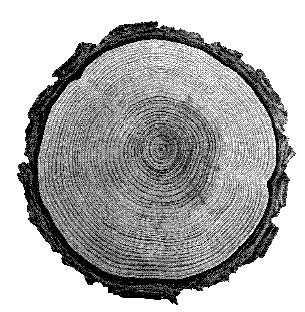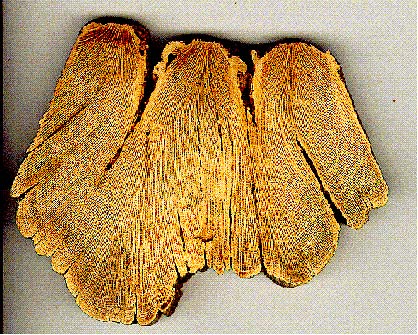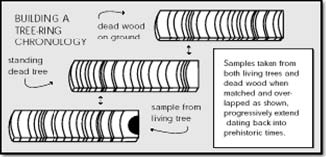Geology and Natural Heritage of the Long Valley Caldera
Dendrochronology
Jack Firestone
Dendrochronology is a process that involves studying tree-ring growth and tree-ring dating in order to piece together a timeline of past events. These events are marked by changes in climate throughout our history, which are reflected in the size and coloration of tree-rings. Today’s technology, combined with tedious work being carried out by scores of persistent researchers, has allowed us to accurately date changes in climate far into the past. In fact, dendrochronologists have gathered data dating back nearly 9,000 years, all the way to 7,000 B.C.E., with help from the chronology created through studying and sampling ancient bristlecone pine trees and their dead wood, which can, and often does, remain intact for thousands of years, if left undisturbed by the numerous researchers and hikers who visit the few sites where these immaculate wonders exist and thrive. (Miller, 1995-2003)
Discovered by A.E. Douglass of the University of Arizona, this technique was first implemented in the early part of the 20th century by botanists, foresters, and archeologists. Douglass noticed that during wet years, certain trees would produce wider rings than normal. In drier years, the rings would be much more narrow. Tree rings are created as new cells are produced starting at the beginning of the growing season. These new cells become the lighter colored portion of the wood when viewing a cross-section of a tree, and grow from the cambium layer in between the layer of old wood from the previous season and the outer bark of the tree. This separation of layers allows for the rings to be easily counted and dated. (Miller, 1995-2003)
As shown in the graphic below, the early-wood of a living tree is made up of many cells with thin cell walls and large diameters, with a lighter appearance in color, as aforementioned. The late-wood has cells with thicker walls and smaller diameters, causing their color to be darker.
University of Arizona's Laboratory of Tree-Ring Research, 1999-2001
There are several basic principles involved in dendrochronology. Arguably the most important of these is the principle of cross-dating. This process is completed by correlating the repeating patterns of rings from the same tree with other trees from different places. To accomplish this task, core samples must be extracted from several trees using an increment borer or other sufficient instrument. These are used to create what is referred to as a ‘living tree chronology.’ The next step requires taking more samples from dead trees in the area, if any remain standing or, if fallen, have not decayed beyond use. The purpose of this step is to extend the chronology back in time further than the first recognizable dates of the youngest living trees. Once an acceptable chronology has been established, the data can be compared with wood specimens found in nearby locations in hopes of finding overlapping sections of ring growth. Through this process, dendrochronologists have been able to date wooden samples from early civilizations that thrived before the advent of recorded history, demonstrating the notion of 'chronology building,' which is frequently utilized in this field. (Martinez, 1996)
The illustration below shows two core samples taken from different trees. Notice how the rings match up, showing a correlation between narrower and wider rings (identified by the lines between samples). This allows the core sample to be dated by the master chronology, if one already exists for the area.

Graphic from the University of Arizona's Laboratory of Tree-Ring Research website, 1999-2001.A second basic rule of dendrochronology is the uniformitarian principle, which states that the same types of processes, physical and biological, that tie current environmental trends and processes with current tree-ring growth patterns must have also occurred and functioned throughout history. Simply put, as originally coined by James Hutton in the year 1785, the present is the key to the past. However, through dendrochronology, the inverse of this statement is also applicable, since this process involves studying relationships between growth and climate change in the past in order to find a better understanding of what the future holds, which has proven to be very beneficial for predicting and managing future environmental conditions. Calibrating tree-ring widths with actual known rainfall records of the past creates precipitation reconstructions, in the form of graphs. Since we have tree-ring samples that date back much further than rainfall records, we can estimate the amount of precipitation prior to the first recorded data based on the comparison of the tree-ring widths with the amount of precipitation during a certain year for which we have recorded information. (Grissino-Mayer, 1994-2003)
Another important principle to the study of tree-ring dating involves limiting factors. This principle states that rates of processes performed by plants are inhibited by the most limiting primary environmental variable. In certain arid and semiarid areas such as the White Mountains, home to many bristlecone pines, the factor that is most limiting to plant growth is often precipitation. Since trees rely on precipitation for growth, and cannot grow faster than the amount of precipitation allows, the width of tree-rings becomes a function of precipitation. Another limiting factor is temperature, which in high latitudes, where the growing season is shorter, is often the most limiting primary environmental variable. Non-climatic factors, such as soil type, often act upon the most limiting factor as well, sometimes compounding the effects of the primary factor. (Grissino-Mayer, 1994-2003)
The principle of ecological amplitude, also referred to as the principle of sensitivity, affirms the idea that tree species are most sensitive to environmental factors, such as temperature, precipitation, humidity, and wind, when they exist at or near the latitudinal and elevational limits of their range. This is an important principle of dendrochronology because the trees that grow closest to these limits happen to be the types that are most useful to dendrochronologists, due to their pronounced and well-defined rings. A species that is broadly distributed and may grow in many differing habitats, such as the ponderosa pine in North America, is said to have a wide ecological amplitude. Conversely, those species that exist in small numbers over a relatively restricted area, such as the bristlecone pines of the White Mountains and other areas with similar elevations and weather and soil conditions, are said to have narrow ecological amplitudes. (Grissino-Mayer, 1994-2003)
The next principle involves site selection, which varies depending on several environmental factors. The sites that have been found to be most useful to dendrochronologists often occur near the limits of a species’ range, and can be recognized and chosen based on the stipulations that cause tree-ring series that occur due to the environmental variable that is being studied. This means that if one wanted to research the effects of prolonged drought on trees, for instance, he or she would search for specimens in areas where there is very limited rainfall, such as within a rain-shadow created by mountain ranges or at the crests of mountains. If this researcher were to obtain samples from trees growing in locations that typically receive great amounts of rain and precipitation throughout each year, the extracted cores most likely would not show tree-ring patterns sensitive to drought, due to the lack of variation in precipitation amounts and the occurrence of rainfall at close intervals. This principle is very important to dendrochronologists because locating a specimen that shows tree-ring series sensitive to the environmental factor being examined becomes much easier and takes far less time than blindly choosing random trees. This process of analyzing historical data and range limits allows a researcher to find a tree whose ring series will benefit the study quicker and more efficiently, saving time, money, and frustration. (Grissino-Mayer, 1994-2003)
An important aspect of dendrochronology, and many other sciences, that ensures data to be accurate is the principle of replication. This concept stresses that it is necessary to take several samples from each tree that is studied, and also to extract samples from many trees at the location being examined. This helps reduce human error and the possibility of data being misconstrued, giving an inaccurate representation of past climatic changes. Taking more than one core from a single tree minimizes the amount of visible environmental signal, perhaps in the form of scars or ring patterns, that is unwanted or unnecessary, commonly called intra-tree variability. Sampling cores from various trees in the given area where the research is being gathered cuts down on noise, or information pertaining to impacts of environmental factors that are not being researched in a particular study. (Grissino-Mayer, 1994-2003)
The last of the core aspects of dendrochronology is explained through the principle of aggregate tree growth. This theory is expressed by a complex equation that incorporates several variables relating to environmental conditions over a period of time. The sum of these variables produces a figure (R), which represents tree-ring growth in any given year: R = A + C + ΩD1 + ΩD2 + E In this equation, adapted from the similar function on the website of Henri Grissino-Mayer (©1994-2003), each variable indicated by a letter should be followed by a sub-scripted 't,' indicating the year number for which the equation is finding a sum. Year one would be indicated with a '1,' year two with a '2,' and so on. The factors that go into this equation are defined by the following: (A) represents the age related growth trend, which is the result of what would be considered normal aging processes over the lifetime of the species; (C) corresponds to the climate that occurred during the year being studied; (D1) symbolizes the disturbance factors which have occurred within the particular area of the forest throughout the year; (D2) stands for disturbance factors that have happened outside the forest stand; and (E) represents random errors that have not yet been accounted for by the other processes present in the function. The (Ω) before both (D1) and (D2) will always be either a '0' or a '1,' depending on whether or not disturbance factors actually occur, since in some years they will be absent or not measurable. In order to gain the most accurate data, the environmental signal that is the general focus of the research, such as climate, should be maximized by minimizing the other variables. For instance, in the event of studying changes in climate, the variables of age related trends and internal and external factors will inhibit normal tree growth and ring production, so they should be minimized.
Not all trees are suitable for use in dendrochronology. There are certain species that consistently produce rings that are easily countable, and others whose rings are so small or not well defined that tree-ring dating is nearly impossible. In the western United States, the Douglas-fir is preferable to almost any other tree because of its concentric, well defined rings, as shown below. The rings show sharp contrast between early and late wood, making counting much easier. Douglas-firs also grow over a very wide range, extending from Canada to Mexico. This enables scientists to create large-scale climate reconstructions over a large area. Ponderosa pines also grow over large ranges and produce uniform, concentric circles, making them suitable for use in dendrochronology. Oak is another preferred species, and is widely used in Europe, where the longest tree-ring chronology in the world was developed, dating about 10,000 years in length. This species is especially useful due to the fact that missing and false rings are very uncommon, so data is almost always an accurate reflection of history. (Martinez, 1996)

(University of Arizona Laboratory of Tree-Ring Research website, Martinez, 1996)Among those species considered unsuitable for tree-ring dating are palm trees, saguaro cactuses, and the majority of trees that do not grow between 25 and 65 degrees latitude, where most of the world's dendrochronological research takes place. As you can see in the image to the right, saguaro cactuses do not produce annual rings, making dating of these large cacti through tree-ring research impossible. Palm trees do not form rings because their insides are made up of only primary xylem tissue, and secondary tissue is necessary to the formation of rings. (Martinez, 1996)

University of Arizona's Laboratory of Tree-Ring Research website, Martinez, 1996An integral part of tree-ring research is chronology building. This involves comparing many different core samples taken from different trees close to one another in hopes of finding overlapping patterns of growth. Outer rings of long-dead trees can be compared with the inner rings of living trees, extending the chronology past the lifetime of currently living trees to find out about the climate variations prior to the existence of younger trees in a stand. The figure above illustrates how these chronologies are built. Through this process, dendrochronologists have been able to build a chronology for the bristlecone pines that extends back nearly 9,000 years, even though the eldest living trees are only 4,000+ years old. (Miller, 1995-2003)
bristlecone dendrochronology website, Miller, 1995-2003Through dendrochronology, we have the ability to solve many problems facing our world in the future, from somewhat insignificant to very serious. Environmental problems facing our world are growing in number and magnitude by the day, and it is important that we address these issues and do what we can to create efficient and feasible solutions. Analyzing tree-rings can tell us a great deal about the effects pollution has on our environment. This knowledge will in-turn lead to the ability to diagnose and hopefully treat and cure the effects of pollution in its earliest stages – arguably the most important application of dendrochronology to our future as inhabitants of the earth. There has also been discussion about benefits to certain irrigation projects through studying and identifying environmental polluters and the effects they have on biota. (Miller, 1995-2003)
Tree rings can be used to identify environmental variants that have slowed or accelerated the growth process. Rings that are narrow and are close together over a period of a few years tell us that growth was greatly slowed during this time, and perhaps, if the specimen comes from a coniferous tree, something occurred causing many needles to die, impeding growth ability. Perhaps repeated storm damage or parasitic insects caused growth to slow down, but more research is necessary before one can come to these conclusions. (Martinez, 1996)
Dendrochronology can also help us date natural disasters such as forest fires. A tree with a core sample that is scarred by numerous burns can be examined and dated in order to determine the exact years in which the fires that left burn marks took place. This information is helpful to land management agencies, such as the U.S. Forest Service and National Park Service, in determining the natural succession of forest fires. It has been discovered in the past few decades that forest fires naturally occurred in practically every forest in the world prior to human intervention in the past century. To restore natural succession within forests, fire must be reintroduced. If it is not, however, then we face the possibility of more intense, disastrous crown fires such as the fires that swept through parts of Arizona, Colorado, and California during the summer of 2002. Scientists at several universities across the United States are already employing these techniques, and a few, such as Professor Tom Swetnam, director of the University of Arizona Laboratory of Tree-Ring Research, predicted the intense blazes of 2002 based on dendrochronological studies. “I would say it wasn't ringing bells or blowing whistles that this was going to be the worst one we've ever seen, but it certainly called it as a season to watch out for and likely to be much worse than average,” (Barber, 2002). Once these patterns are more fully understood, fire management plans can be developed that recommend prescribed burns at intervals similar to those that occur in nature, effectively rejuvenating forest ecosystems. (Martinez, 1996)
In fact, these are only a few of the uses which dendrochronology provides the scientific world. Others fields that utilize information gathered through tree-ring research include, “climatology, hydrology, anthropology, archeology, forest ecology, tree physiology, Quaternary studies, geomorphology, geophysics, and geochemistry,” (Laboratory of Tree-Ring Research, 1999-2001). Though the intricacies of this field are foreign to most, the use of dendrochronology is growing world-wide, and will likely be used even more over the next few centuries as a tool of dating the past and predicting the future.
Bibliography
Barber, D.A. “Wildfire: Climate Scientists Foresaw Arizona Conflagrations.” The University of Arizona Report on Research: Institute for the Study of Planet Earth. Pages 16-18. © 2002.
Grissino-Mayer, Henri. “Principles of Dendrochronology.” The Ultimate Tree-Ring Web Pages. © 1994-2003. Website: http://web.utk.edu/~grissino/principles.htm . Last updated May 16, 2003.
Laboratory of Tree-Ring Research, The University of Arizona. © 1999-2001. Website: http://www.ltrr.arizona.edu Links visited: mission.html, dendrochronology.html. Last updated July, 2001. Martinez, Lori. Laboratory of
Tree-Ring Research, The University of Arizona. © 1996 Website: http://tree.ltrr.arizona.edu/lorim.html . Links visited: apps.html, bad.html, basic.html, good.html. Last updated February, 2000. Miller, Leonard. “
Dendrochronology.” The Ancient Bristlecone Pine. © 1995-2003. Website: http://www.sonic.net/bristlecone/dendro.html . Last updated January 1, 2003.
